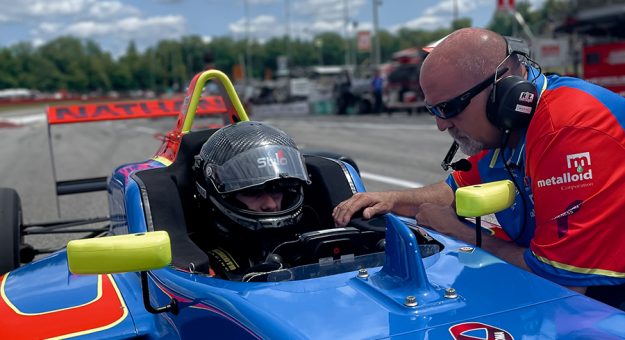LEXINGTON, Ohio – One word describes last weekend: jarring!
I made my USF2000 debut at the Mid-Ohio Sports Car Course and I learned that I was woefully unprepared to drive a USF2000 car. Not in terms of car control or prior car experience, but in terms of physicality.
The USF2000 car is the most physically demanding car I’ve ever driven and during the course of the weekend I realized that in order to drive the car faster and faster it actually takes more and more energy output.
I was shocked and surprised by the realization that my development as a driver in a new car was being limited by physical fatigue and not seat time. That had never happened to me before and definitely created a scared straight moment where I never want to be back in that situation again.
In my defense, it also didn’t help that I was making my USF2000 road course debut at arguably the most physically demanding track on the Road to Indy schedule, Mid-Ohio. Nonetheless, I did my best given my level of preparation.
The weekend was filled with progress in terms of pure driving pace and car comfort. From the initial practice sessions where I honestly didn’t get that much dry, open track seat time, to qualifying and races one, two and three, I got faster and faster and closed my pace gap to the competition slowly but surely.
It was actually interesting because the first practice session we had was on a wet track that was slick from rain earlier in the day. I was fast compared to the competition all weekend in those conditions, sitting P13 in practice.
That was because the way you needed to drive the car in those conditions much better suited the way I typically to drove all the other formula-style cars I’ve been in. I only realized later why this was the case and it had to do with what made the car so unique and physically exhausting to drive in the first place.
The USF2000 car has significantly more grip. That means it drives more like a low horsepower momentum car where entry and mid-corner speed is the key to lap time. It also meant that in order to drive the car fast you had to be constantly feeding steering into the car, even past the apex.
That is not how you drive any of the other formula-style cars I’ve been in. This method of driving, especially at Mid-Ohio, is very exhausting because you’re constantly taking G’s to the upper body from turn four all the way back through turn one.
There’s very little time to breath on a lap and you only get a few moments to relax the grip on the back straight from turn two to four. That is why I was grateful whenever a caution came out during the races. I ended up last in qualifying, meaning I started last in each race.
In race one there was a bit of action in the beginning of the race when the caution flag waved a few times, but the rest of the race went green to checkered with very little action. It was pretty much just another practice session where I started 28th and finished 23rd.
Race two was a little bit more spicy. It went green to checkered, which meant I was wheeling the car around for 40 minutes straight just trying to get as comfortable with the car and track as possible while running as hard as possible to bring my lap times down.
As you already know, the harder you drive the car, the faster you’ll go, but the more worn out you’ll be. Boy, was that the truth when I had practically fallen out of the seat with seven laps to go.
My pure exhaustion (and poor decision making) is actually what caused an accident on the penultimate lap with a competitor that landed us both in the grass. Luckily, I still finished 23rd with a flat right front tire, but understandably got a 30 second time penalty that dropped me down a spot to 24th.
I apologized to my competitor after the race and determined in that moment to never again let my physical exhaustion be the primary cause of a racing incident.
In race three I got to experience a lot more racing action because the race was slowed three times by cautions, which repeatedly bunched the field together and allowed me to practice my restarts. It also gave me more of a break from the physical fatigue. I ended up finishing 22nd in the third race after getting as high as 21st at one point.
It was not a bad race weekend at all and I definitely couldn’t have done it without the help of my teammate Simon Sikes, who managed to triple podium with two third-place finishes and a runner-up finish. He helped fast track my learning process significantly, no pun intended, with his help in reviewing his and my practice and race footage.
Legacy Autosport gave me a car that I knew was competitive, I just didn’t have the physical conditioning nor experience to wheel it around like Simon did. However, I improved every session and got to learn a new track and car and learned a lot about what is needed so I’ll be better prepared the next time I’m in the car.
I can’t wait to get back in the car in October back at Mid-Ohio, where hopefully my training pays off and I can conquer the beast and perform even better.
